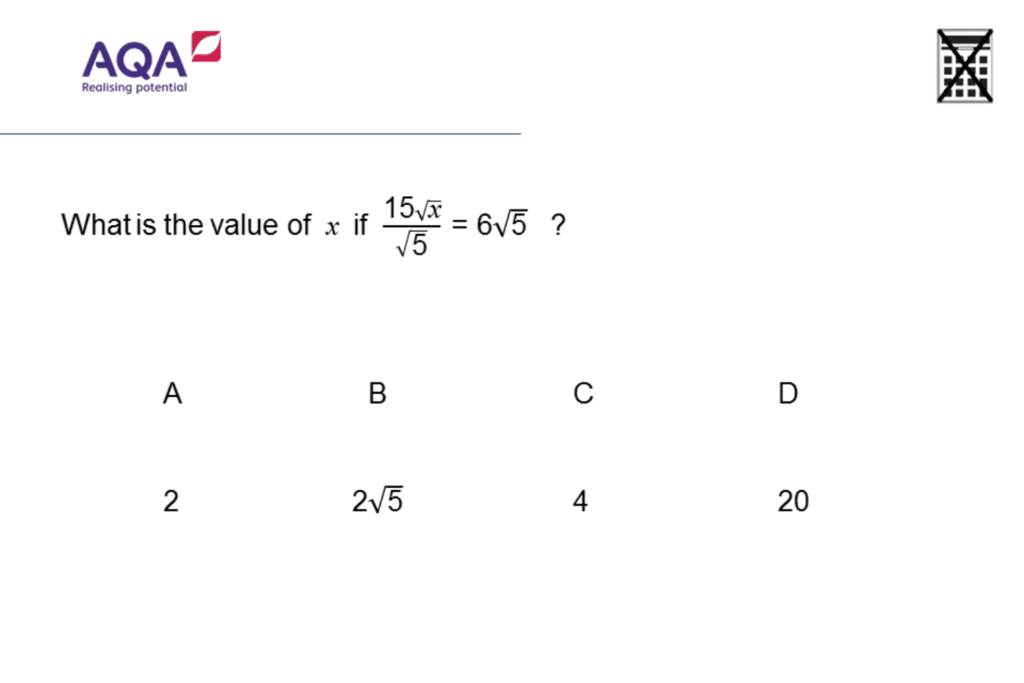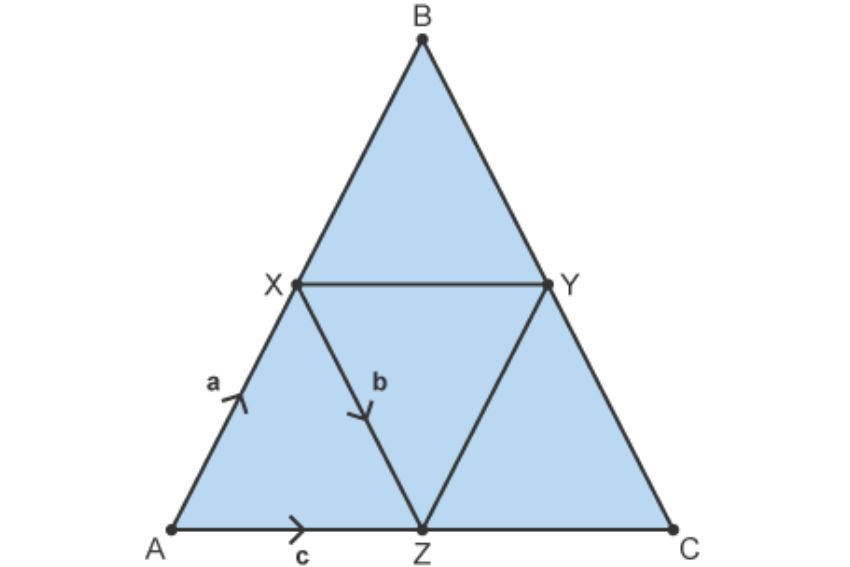23 GCSE Maths Questions to Boost Your Grades
Preparing for GCSE Maths can be a challenging journey, but one of the best ways to build confidence and improve your skills is through practice. GCSE Maths exams test a wide range of mathematical concepts, from basic arithmetic and algebra to more complex topics like trigonometry and probability.
In this blog, we’ll explore various GCSE Maths questions, providing examples that mirror those you might encounter in the exam.
Whether you’re aiming for a solid pass or striving for top grades, practising these questions will help you strengthen your problem-solving abilities and ensure you’re ready for the challenges ahead. Dive in and start tackling the questions that will set you up for success in your GCSE Maths exams!
Foundation Level (Easier)
1. Fractions: Simplification
Question: Simplify
Answer:
Tip: Find the greatest common divisor (GCD) to reduce the fraction to its simplest form.
Explanation: Simplifying fractions requires dividing both the numerator and the denominator by their greatest common divisor (GCD). Students need to be comfortable identifying the GCD and performing division accurately. A common pitfall is failing to fully simplify the fraction, leaving it in a non-reduced form.
2. Statistics: Mean Calculation
Question: Find the mean of the numbers 4, 8, 12, 16, and 20.
Answer: 12.
Tip: The mean is calculated by dividing the sum of the numbers by the count of numbers.
Explanation: Finding the mean requires adding all data points and dividing by the number of points. Students must be confident in performing these operations accurately. Mistakes often arise from incorrect addition or division, especially when dealing with larger numbers or decimal values.
3. Geometry: Angles in a Triangle
Question: In a triangle, two angles are 45° and 65°. Find the third angle.
Answer: 70°
Tip: Remember, the sum of angles in a triangle is always 180°. This is a foundational principle in geometry.
Explanation: Understanding the properties of triangles is essential here, specifically that the sum of angles in any triangle is always 180°. Students often forget this fundamental rule or miscalculate the sum of given angles. Accurate arithmetic and attention to detail are key in avoiding errors.
4. Percentages: Percentage Increase
Question: Increase £120 by 15%.
Answer: £138.
Tip: Use the formula
Explanation: Calculating percentage increases involves multiplying the original amount by the percentage as a decimal. This requires proficiency in decimal multiplication and addition. Mistakes often occur when students incorrectly convert the percentage to a decimal or forget to add the percentage increase back to the original amount.
5. Algebra: Simplifying Expressions
Question: Simplify
Answer: 6x
Tip: Combine like terms to simplify expressions efficiently.
Explanation: Simplifying algebraic expressions involves combining like terms. Students must correctly identify and group terms with the same variable. A common mistake is incorrectly adding or subtracting coefficients, leading to an incorrect simplified expression.
6. Ratios
Question: Divide £200 in the ratio 3:2.
Answer: £120 and £80.
Tip: Add the parts of the ratio and divide the total amount accordingly.
Explanation: Solving ratio problems requires dividing quantities into parts based on the ratio given. Students must be careful in setting up the correct proportional relationships. Errors often stem from misinterpreting the ratio or failing to distribute the total amount correctly.
7. Geometry: Area of a Circle
Question: Calculate the area of a circle with a radius of 7 cm.
Answer: 154 cm².
Tip: Use the formula
Explanation: Calculating the area of a circle requires using the formula. Students must accurately square the radius and multiply by π\piπ. Mistakes often occur when students incorrectly square the radius or use an incorrect value for π\piπ.
Example of AQA maths question – cicrle

8. Transformations
Question: Reflect the point (2, 3) across the y-axis.
Answer: (-2, 3).
Tip: Remember, reflection across the y-axis changes the sign of the x-coordinate.
Explanation: Reflecting points across an axis requires students to understand the properties of reflection. In this case, reflecting across the y-axis means changing the sign of the x-coordinate. Common mistakes include changing the wrong coordinate or misinterpreting the axis of reflection.
Intermediate Level (Moderate Difficulty)
9. Algebra: Solving Linear Equations
Question: Solve for –
Answer:
Tip: Always isolate the variable by performing inverse operations. Ensure each step is clear in your working.
Explanation: Solving linear equations requires a clear understanding of balancing equations. Here, the equation 3x−7=143x – 7 = 143x−7=14 involves isolating xxx. Students need to confidently perform operations such as adding and dividing while maintaining equality on both sides. A common mistake is forgetting to apply the operation to both sides, which can lead to incorrect results.
10. Algebra: Factorising Quadratics
Question: Factorise
Answer:
Tip: Look for two numbers that multiply to give the constant term and add to give the coefficient of xxx.
Explanation: Factorising quadratics first involves identifying two numbers that multiply to give the constant term and then add to give the middle term coefficient. However, students often struggle with selecting the correct factor pairs or even incorrectly factorising.Find two numbers that multiply to 20 and add to -9 (those numbers are -4 and -5). So, the factorised form is (x−4)(x−5).
11. Indices
Question: Simplify
Answer:
Tip: When multiplying powers with the same base, add the exponents.
Explanation: Working with indices requires knowledge of the laws of exponents. Students must correctly apply the rule that states when multiplying powers with the same base, you add the exponents. Common errors include multiplying the bases instead of the exponents.
12. Surds
Question: Simplify
Answer:
Tip: Express the number under the square root as a product of a perfect square and another number.
Explanation: Simplifying surds involves expressing a number as a product of its factors and then simplifying. Students need to be proficient in identifying perfect squares and correctly applying square root rules. Errors can arise from incorrect factorisation or mishandling of the surd.Express 50 as a product of a perfect square and another number:
13. Algebraic Fractions
Question: Simplify
Answer: x+1
Tip: Factorise the numerator as (x−1)(x+1), then simplify by cancelling x−1 from both numerator and denominator.
Explanation: Simplifying algebraic fractions first requires factorising the numerator and then cancelling common factors with the denominator. In addition, students must be adept at recognising factorable expressions. Unfortunately, a common error is either cancelling terms incorrectly or failing to factorise fully. Thus, attention to detail is critical in avoiding these mistakes.
Example of GCSE math question – Algebra

14. Volume of a Cylinder
Question: Find the volume of a cylinder with a radius of 5 cm and a height of 10 cm.
Answer: 785 cm³.
Tip: Use the formula
Explanation:Finding the volume of a cylinder first involves using the formula. Next, students must be careful in squaring the radius and multiplying by the height. However, errors can arise from the incorrect application of the formula or calculation mistakes. Therefore, it is crucial to double-check each step to ensure accuracy.
15. Trigonometry: Sine Rule
Question: In a triangle, find the length of side aaa, where
Answer: (Example-specific).
Tip: Apply the sine rule: especially useful in non-right-angled triangles.
Explanation: Applying trigonometric functions, such as the sine rule, first requires understanding the relationship between sides and angles in a triangle. After that, students need to confidently set up the correct ratio and then solve for the unknown. However, misapplication of the rule or incorrect calculator usage can easily lead to errors. Thus, it is important to double-check each step to ensure accuracy.
16. Simultaneous Equations
Question: Solve the system: 3x+y=7 and x−y=3
Answer: x=2 y=1
Tip: Solve one equation for one variable (e.g., y=3x−7) and substitute into the other equation to find x and y.
Explanation: Solving simultaneous equations involves either substitution or elimination. Students must correctly apply one of these methods and handle arithmetic carefully. Errors often occur in solving for one variable or substituting back into the equations.
Higher Level (Challenging)
17. Pythagoras’ Theorem
Question: In a right-angled triangle, one leg is 6 cm, and the other is 8 cm. Find the hypotenuse.
Answer: 10 cm.
Tip: Apply Pythagoras’ theorem: where c is the hypotenuse.
Explanation: Pythagoras’ theorem is fundamental in solving problems involving right-angled triangles. Firstly, students need to correctly apply the formula. However, a common error is either forgetting to square the lengths of the legs or incorrectly simplifying the square root. Therefore, precision in calculation is absolutely essential to avoid mistakes.
18. Circle Theorems
Question: In a circle, the angle at the centre is twice the angle at the circumference. If the angle at the circumference is 30°, find the angle at the centre.
Answer: 60°.
Tip: This is a key circle theorem often tested in exams. 2×30°=60°.
Explanation: Understanding circle theorems, such as the angle at the centre being twice the angle at the circumference, is crucial. Students need to recall and apply this theorem accurately. Misunderstanding the relationship between angles in a circle is a common mistake.
19. Vectors
Question: Given vectors a=(2,3)\mathbf{a} = (2, 3)a=(2,3) and b=(4,−1)\mathbf{b} = (4, -1)b=(4,−1), find a+b\mathbf{a} + \mathbf{b}a+b.
Answer: (6, 2).
Tip: Add corresponding components of the vectors.
Explanation: Adding vectors first involves adding their corresponding components. Next, students need to correctly identify and then add the x and y components separately. However, errors can arise from either mixing up components or performing incorrect arithmetic. Thus, careful attention to detail is crucial to avoid mistakes.
Example of GCSE maths question – Vectors

20. Sequences
Question: Find the nth term of the sequence 3, 7, 11, 15, …
Answer: 4n−14n – 14n−1.
Tip: Identify the common difference and use the formula for the nth term of an arithmetic sequence.
Explanation: Finding the nth term of a sequence initially requires identifying the common difference and then forming an algebraic expression. However, students often struggle with identifying the correct pattern or forming the correct expression. Therefore, understanding arithmetic sequences is crucial for success in this area.
21. Compound Interest
Question: £1000 is invested at an interest rate of 5% per annum compounded yearly. What will the total amount be after 3 years?
Answer: £1157.63.
Tip: Use the compound interest formula:
Explanation: Calculating compound interest involves applying the formula. Students must be proficient in working with percentages, exponents, and order of operations. Common errors include incorrect application of the formula or calculator mistakes.
22. Probability: Simple Probability
Question: A bag contains 3 red, 5 blue, and 2 green marbles. What is the probability of drawing a blue marble?
Answer:
Tip: Probability is calculated as
Explanation: Probability calculations involve determining the ratio of favourable outcomes to total outcomes. Students should be comfortable counting and simplifying fractions. Errors often occur when students miscount the number of outcomes or fail to simplify the probability fraction.
23. Advanced Algebraic Manipulation
Question: Rearrange the formula c=25(a−3b) to solve for b.
Answer:
Tip: When rearranging formulas, focus on isolating the variable you need. Start by simplifying the equation as much as possible, then work step by step to solve for the target variable. Remember to perform the same operation on both sides of the equation to maintain balance.
Explanation: To rearrange the formula c=25(a−3b) and solve for b
- Expand the Equation: Start by expanding the right-hand side of the equation to simplify it: c=25a−75b
- Isolate the Term Involving b: Move the term involving b to one side of the equation by subtracting 25a from both sides: c−25a=−75b
- Solve for b: Divide both sides of the equation by −75 to isolate b:
- Alternatively, you can split the fraction into two separate terms:
- Simplify the first term:
This final expression for b clearly shows the variable isolated on one side of the equation, with all other terms simplified. However, a common mistake students might make is either not fully simplifying the fractions or misapplying the order of operations. Therefore, attention to detail is crucial in advanced algebraic manipulation.
Final Tips
- Practice Regularly: Consistency is key. Make sure to solve a variety of questions daily.
- Understand the Concepts: Don’t just memorise the formulas—understand the underlying principles.
- Time Management: Practice under timed conditions to improve your speed and accuracy.
- Use Resources Wisely: Incorporate a mix of textbooks, online resources, and past papers into your study routine.
By tackling these 23 questions and following the tips provided, you’ll be well on your way to mastering GCSE Maths. Keep practising, stay focused, and remember success in Maths comes from understanding, not just memorisation.
GCSE Maths Questions Categorised by Topic
To help you focus on specific areas of the GCSE Maths curriculum, we’ve categorised our 23 questions into the most common topics:
- Algebra – Simplifying expressions, solving equations, and factorising quadratics.
- Geometry – Working with angles, areas, and volumes.
- Statistics – Calculating averages and interpreting data.
- Probability – Understanding likelihood and using probability rules.
- Trigonometry – Applying trigonometric ratios and solving triangles.
- Indices and Surds – Simplifying powers and roots.
Each topic is integral to GCSE Maths, and practising these questions ensures comprehensive coverage of the syllabus.
How These 23 Questions Reflect Real GCSE Exams
Our 23 questions are carefully designed to mirror the style and difficulty of real GCSE exam questions. To begin with, they include a mix of foundation and higher-tier questions, covering the full spectrum of the syllabus.
Furthermore, these questions are based on past papers from exam boards like AQA, OCR, and Edexcel, thereby ensuring that they are relevant and up-to-date. By practising these questions, students can effectively develop the problem-solving skills needed to tackle similar questions in their exams.
FAQs
How much time should I spend revising for GCSE Maths each week?
It’s recommended that students spend between 3 to 4.5 hours per week on maths during school time, with an additional 30 minutes to an hour per week on homework. However, increasing this to around 6 hours per week, including independent study and practice, can significantly improve performance.
What are the key topics I need to focus on for GCSE Maths?
Key topics include Number (fractions, decimals, percentages), Algebra (equations, sequences), Geometry (angles, area, volume), Ratio and Proportion, Probability, and Statistics. These form the foundation of both the foundation and higher-tier papers.
What happens if I get stuck on a question during my revision?
If you get stuck, it’s essential to revisit the topic and try to understand the underlying concept. You can also reach out to a tutor or use online resources that offer step-by-step explanations. Practice is key to overcoming difficult questions.
How do I effectively tackle difficult GCSE Maths questions?
First, break down the problem into smaller parts and then identify the mathematical principles involved. Additionally, practising past papers can further help you become familiar with the types of questions as well as the level of difficulty. This approach allows for a more organised and effective problem-solving process.
What should I do on the day of the GCSE Maths exam to maximise my performance?
Ensure you are well-rested, arrive early, and bring all necessary equipment, such as a calculator, ruler, and compass. During the exam, read each question carefully, manage your time efficiently, and tackle the questions you find easiest first before moving on to more challenging ones. For more information check out How to Get a 9 in GCSE Maths
Conclusion
Mastering GCSE Maths requires consistent practice, a deep understanding of various topics, and the ability to tackle problems with confidence. By working through these 23 questions, you have covered a wide range of mathematical concepts, from algebra and geometry to statistics and trigonometry. The detailed explanations provided with each answer help you understand not only how to solve the problems but also the reasoning behind each step.
Remember, the key to success in GCSE Maths is not just memorising formulas but also applying them effectively in different contexts. Keep practising, and don’t hesitate to revisit topics that challenge you. Use the downloadable resources to further reinforce your understanding, and take advantage of additional support if needed.








